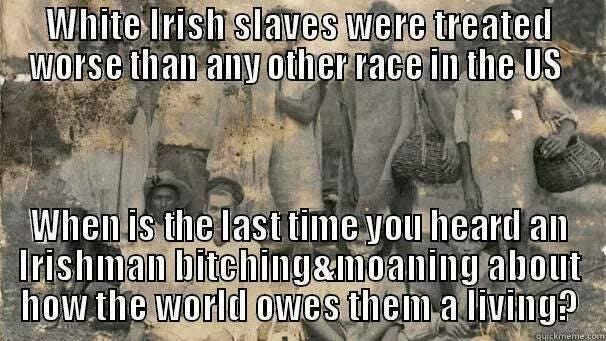The white slaves history forgot
The Irish slave trade began when 30,000 Irish prisoners were sold as slaves to the New World in the early 1600s. The King James I Proclamation of 1625 required Irish political prisoners be sent overseas and sold to English settlers in the West Indies. By the mid 1600s, the Irish were the main slaves sold to Antigua and Montserrat. At that time, 70% of the total population of Montserrat were Irish slaves.
Ireland quickly became the biggest source of human livestock for English merchants. The majority of the first wave of slaves to the New World were actually white.
From 1641 to 1652, over 500,000 Irish were killed by the English and another 300,000 were sold as slaves. Ireland’s population fell from about 1,500,000 to 600,000 in one single decade. Families were ripped apart as the British did not allow Irish dads to take their wives and children with them across the Atlantic. This led to a helpless population of homeless women and children. The 'solution' was to auction them off as well.
During the 1650s, over 100,000 Irish children between the ages of 10 and 14 were taken from their parents and sold as slaves in the West Indies, Virginia and New England. In this decade, 52,000 Irish were sold to Barbados and Virginia. Another 30,000 Irish men and women were also transported and sold to the highest bidder. In 1656, Cromwell ordered that 2000 Irish children be taken to Jamaica and sold as slaves to English settlers.
Many people today will avoid calling the Irish slaves what they truly were: Slaves. They’ll use misleading terms like “Indentured Servants” to describe what occurred to the Irish. However, in most cases from the 17th and 18th centuries, Irish slaves were nothing more than human cattle.
| 'Human cattle' |
African slaves were very expensive during the late 1600s (50 Sterling). Irish slaves came cheap (no more than 5 Sterling). If a planter whipped or branded or beat any slave to death, it was never a crime. A death was a monetary setback, but far cheaper than killing a more expensive African. The English masters quickly began breeding the Irish women for both their own personal pleasure and for greater profit. Children of slaves inherited their parents' bondage, which increased the size of the master’s free workforce. Even if an Irish woman somehow obtained her freedom, her kids would remain slaves of her master. Thus, Irish mothers, even with rare emancipation, would seldom abandon their kids and would often remain in servitude.
In time, the English thought of a better way to use these women to increase their market share: The settlers began to breed Irish women and girls with African men to produce slaves with a distinct complexion. These new “mulatto” slaves brought a higher price than Irish livestock and, likewise, enabled the settlers to save money rather than purchase new African slaves. This practice of interbreeding Irish females with African men went on for several decades and was so widespread that, in 1681, legislation was passed “forbidding the practice of mating Irish slave women to African slave men for the purpose of producing slaves for sale.” In short, it was stopped only because it interfered with the profits of a large slave transport company.
England continued to ship tens of thousands of Irish slaves for more than a century. Records state that, after the 1798 Irish Rebellion, thousands of Irish slaves were sold to both America and Australia. There were horrible abuses of both African and Irish captives.
The omission of Irish slavery from the accounts of the horrific trade has obscured the truth of the trade in human beings. Slavery was not only an African experience. This leads me to conclude that race was not the sole reason for the Trans-Atlantic trade, despite popular belief. The religious and perceived cultural disparity between the Irish and English was sufficient to dehumanise and enslave the people of Ireland, it was merely a handy coincidence for slave owners to extend this prejudice against Africans with the pseudo-scientific concepts of racial higherachy. The thousands of Irish and Scottish slaves, who built the foundations fro Britain's greatness with their toil and blood have been largely omitted from the pages of history, and do not even merit a memorial. Their omission is unforgivable, they are the slaves that history forgot. However, this rightful campaign has been exploited by groups of eccentric racists in the US. They exaggerate the brutality of the Irish treatment to diminish the campaigns of groups such as Black Lives Matter who seek greater welfare for the victims of the African diaspora, they have spawned a series of derogatory 'memes'. This is the wrong approach to rewriting the enslaved=-Irish into history, if both ethnicities can share in the evils of the slave trade, than both should also share in the public memorial and commemoration, something that has been sorely lacking.
 |
| A racist 'meme' exploiting and exaggerating (the Irish were not treated as brutally as Africans) history for their bigoted agendas |
'Slavery and the British Empire' - Kenneth Morgan
Comments
Post a Comment